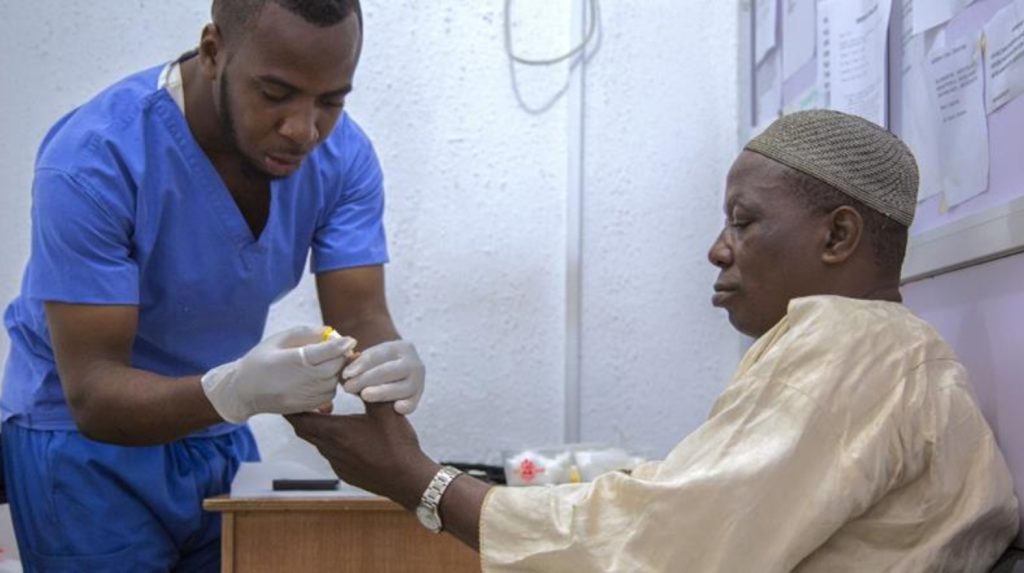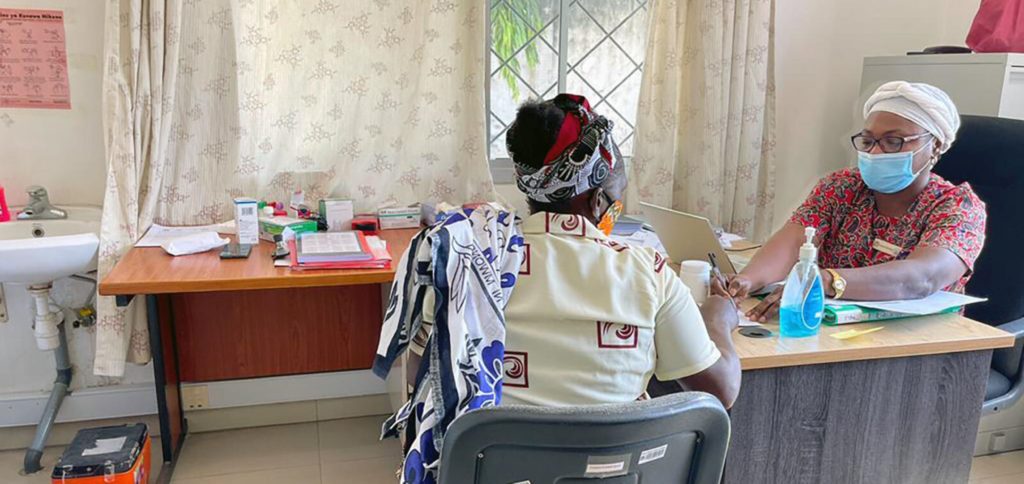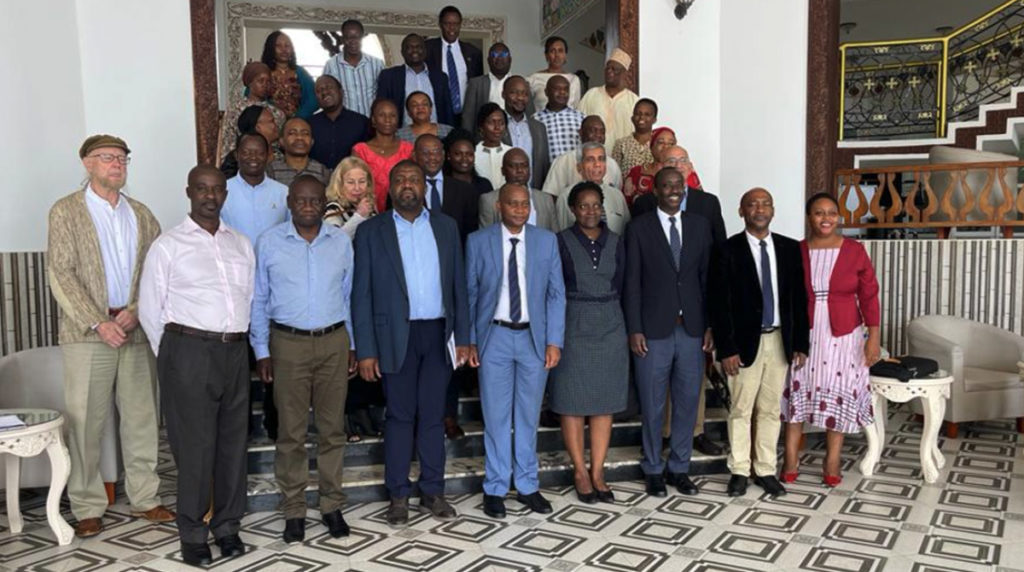Non-communicable diseases like hypertension and diabetes have emerged as serious health crises in developing countries, as HIV was a decade ago. New models of primary health care that combine NCD and HIV care are catching on – and Tanzania is one example.
DAR ES SALAAM, Tanzania – Lying on a neatly made bed at Muhimbili National Hospital (MNH), Zaituni Kashozi is recovering from surgery to amputate her gnarled toes that were infected by diabetic ulcers.
Wrapped in iodine-stained bandage, her left foot dangles on a string attached to an aluminium bar that helps to propel her feeble blood circulation.
The 74-year-old, who has grappled with diabetes for three decades, woke up to a grim reality a year ago when insidious infections took root, forcing her to go under the surgeon’s scalpel.
“I don’t feel any pain on my feet. All the sense of touch is gone. Even if you prick me with a needle, I won’t feel it. What a terrible disease,” Kashozi laments.
Within the walls of this 1,500-bed medical facility, the toll of diabetes is strikingly evident. Ward after ward echoes with the woes of chronic foot ulcers even blindness—a reflection of the toll diabetes is taking on the urban populace.
Diabetes, a chronic metabolic disease, poses a serious health threat that can affect the heart, blood vessels, eyes, kidneys and nerves.
In Tanzania, an estimated 12.8% of the population had diabetes by 2021 – up from little over 2% in a decade. The elderly, like Kashozi, bear a huge burden of NCDs, and around 90% of those aged 50 and above navigate the labyrinth of health challenges without the safety net of health insurance, forcing them to dart between hospitals frantically seeking elusive medical care.
HIV and NCD management under one roof
On the other side of the city, Halfani Ali, a 53-year-old father of five, is struggling with the dual challenges of HIV/AIDS and diabetes.
Since his HIV diagnosis in 2003, Ali has been receiving care and medication at various health centres across the city. However, in 2013, Ali’s life took an unexpected turn when he was diagnosed with diabetes.
This dual burden of disease has presented a complex challenge, forcing him to juggle HIV and diabetes appointments at two different health centres.
Recognizing the struggles faced by individuals like Ali, the Temeke Regional Referral Hospital in Dar es Salaam (TRRH) integrated health care for NCDs within the ambit of HIV services in 2023.
Now individuals like Ali can manage coexisting conditions like diabetes and hypertension under the same roof.
“I am very happy because I get all my medication at Temeke Hospital. I don’t have to travel all the way to Kariakoo to see a diabetes specialist,” says Ali, reflecting the relief he has experienced with the integrated approach.

Maria Bitwale, a senior oncologist at Temeke Hospital, says many HIV patients with diabetes are now seeking treatment, and the integrated approach is helping to deter potential health crisis triggered by diabetic complications.
On a bright Saturday morning, Ali approaches the physician’s desk where his examination unfolds meticulously. Bitwale, armed with a patellar hammer, probes the nuances of his nerves, safeguarding against the perils of diabetic complications.
Ali’s eyes light up as he recounts the doctor’s advice on nerve function control and a prescribed diet, ensuring he remains in robust health.
In this amalgamation of medical expertise and personal resilience, Ali’s story is testimony to the success of integrated healthcare approach for killer diabetes, HIV and hypertension – diseases which previously could have led to a death sentence, alone or together.
HIV is an entry point for NCD care
In Tanzania, over 1.4 million people out of the country’s 61 million population are living with HIV. Of these, an estimated 29% have hypertension and 13% have diabetes. And it is these latter diseases that are now the main causes of death in Tanzanians living with HIV today.
Integrating up NCDs care into HIV services, which are widely available at the primary health care level, is the one new model being used to diagnose, prevent and manage leading chronic diseases in a cost-effective manner.
John Njingu, Tanzania’s Permanent Secretary at the Ministry of Health, emphasises that integration of NCDs into primary healthcare facilities nationwide, extending to HIV-targeted clinics, where the screening and management of NCDs are offered to people with or without HIV under one roof.
“We want to bring better health care services to the people at lower cost to the service providers and the patients themselves,” he told Health Policy Watch in an interview.
The NCD response in Tanzania took a major leap forward in 2019 on World Diabetes Day, when a new National NCD Prevention and Control Programme was launched by Tanzania’s Prime Minister, Kassim Majaliwa.
The NCD strategy has been rolled out in 700 primary health care clinics in 26 regions across Tanzania, 245 of them in the first stage. These PHC centres have been provided with basic NCD diagnostic equipment, and over 3,000 health care staff working at the centres have been trained in basic NCD care.
The new programme builds on several years of effort by the Ministry of Health and national stakeholders to establish the necessary platform for NCD services to reach communities.
The new strategy has been supported by a range of national as well as international partners, including World Health Organization (WHO), the Global Fund, the US President’s Emergency Fund for AIDS Relief (PEPFAR), and UNAIDS.
The WHO guidelines call for HIV-NCD service integration across the continuum of care as does the 2021 Political Declaration of the UN General Assembly High-Level Meeting on HIV and AIDS.
But there is still a long way to go, as the country has a total of 8,549 primary, secondary and tertiary heath facilities, according to the Ministry of Health.

‘Unprecedented’ in sub-Saharan Africa
“What we have seen unfolding in Tanzania with basic NCD services for very common conditions such as diabetes and hypertension now reaching primary care across the country at this scale is arguably unprecedented in a sub-Saharan African context,” says Bent Lautrup-Nielsen, head of global advocacy at the World Diabetes Foundation (WDF).
WDF began supporting NCD interventions in the country two decades ago, and has played a key supporting role in the new NCD programme launch.
“With the strong results on NCDs achieved by the Ministry of Health, the President’s Office for Regional Administration of Local Government and key national partners such as Tanzania Diabetes Association and Tanzania NCD Alliance, the prospect of integrated primary care with NCDs becoming part of routine services everywhere alongside HIV, TB and maternal and newborn care are now quite promising,” said Lautrup-Nielsen.

New research findings demonstrating the benefits of integration also have helped pave the way for broader change. In a ground-breaking study dubbed INTE-Africa, conducted in Tanzania and Uganda in 2022, scientists documented the benefits of merging and decentralising services for HIV, diabetes, and hypertension in terms of disease management and cost-savings.
The study, published in The Lancet in 2023, found that integrated management resulted in a 75% higher rate of retention in care for people with HIV and one or more NCD conditions; did not adversely affect viral suppression rates among people with HIV; and was cost-saving in terms of the health services provided.
The researchers randomly allocated 32 health facilities (17 in Uganda and 15 in Tanzania) serving 7,028 eligible patients, to integrated care or standard care groups.
In the integrated care group, participants with HIV, diabetes or hypertension, were managed by the same health workers, used the same pharmacy, and had uniform medical records, registration and laboratory services. In the standard care group, patients attended separate standalone clinics for each condition, following the standard practice in sub-Saharan Africa.
Data collection was conducted at baseline, as well as months six and 12. Retention was assessed through routine clinic attendance and track-and-trace procedures.
Roadmap for policymakers
The study’s findings lay out a roadmap for policymakers, not just in Tanzania and Uganda, but more widely across Africa for scaling up integrated care for conditions such as HIV, diabetes, and hypertension, saving money while providing effective care.
The idea of anchoring such care in HIV clinics is based on the success in providing HIV patients with steady care, resulting in dramatic suppression of viral load. The death toll for this group has plunged from a peak of two million annual deaths in the early 2000s to fewer than 500,000 deaths in 2022, researchers say.
Inspired by the INTE-Africa trial, Tanzania, which had for many years embraced infectious diseases as its priority in health policy and resources allocations, is undergoing a seismic shift in its primary health care services to address the new NCD crisis.
The integration of HIV, diabetes and hypertension services has earned global recognition, as reflected in the NCD Alliance’s Spending Wisely report, which also found “evidence is strong that integrated services can deliver health impact.”
The shift in Tanzania’s policy also aligns with the evolving strategy of the Global Fund dubbed Prioritization Framework Supporting Health Longevity Among People Living with HIV, which articulates the opportunities and priorities for integrated investments to prevents, identify and managed advanced HIV disease and NCDs, among other diseases, for the period of 2023-2025.
The strategy calls for integrating NCD services into other services designed for people living with HIV, especially those over the age of 50.
Countries are encouraged to align services with the WHO package of essential NCD disease interventions for primary health care focusing on cardiovascular and chronic respiratory diseases, diabetes and early diagnosis of cancer.
Global Fund specialist Dan Koros told Health Policy Watch that the Fund’s support for NCD Integration into HIV programs in Tanzania began in January 2024 with a grant of $115,075 – primarily for carrying out baseline assessment, developing protocols and training healthcare workers for the period of 2024-2026.
The Global Fund investments aim to support integrated diagnosis and treatment of HIV positive adults over the age of 40 and on antiretroviral treatment, who are also receiving treatment for one or more NCD, including cardiovascular disease, hypertension, diabetes, obesity, and mental health conditions.

NCD’s – highest premature mortality is in LMICs
Globally the NCDs are the leading cause of death, killing 41 million people each year-equivalent to 71% of all deaths worldwide. And the highest rates of premature mortality – that is deaths before the age of 70, are in low- and middle-income countries, particularly Africa.
Across the WHO’s African region, patients suffering from diabetes and hypertension are neglected, with less than half remaining in care one year after diagnosis, leading to approximately two million deaths each year, medical researchers say.
And when their disease condition is addressed later in life, it also makes treatment much more complex. Many elderly patients like Kashozi, suffering from diabetic ulcers and related complications, do not always get access to specialised care.
“The ageing process affects immune function and slower wound healing, making the treatment of diabetic foot ulcers even harder,” says Zawadi Chiwanga, senior endocrinologist and lead surgeon in Kashozi’s case.
“Diabetic ulcers can be particularly insidious, often manifesting silently without the knowledge of a patient until they reach an advanced stage,” Chiwanga told Health Policy Watch.
Diabetes affects younger people too
While traditionally Tanzanians perceived diabetes as a disease that primarily haunts the elderly, the city of Dar es Salaam, one of Africa’s fastest growing urban areas, bears witness to a different reality.
From Tandale, a labyrinthine slum, to the upscale enclave of Masaki, favoured by Western diplomats, and further to Kariakoo, a business hub replete with fast- food joints, youth obesity is on the rise – accompanied by an alarming surge in diabetes cases.
Out of the 613,210 patients screened for diabetes at MHN in the last six months, an estimated 165,566 individuals (27%), were diagnosed with diabetes, hospital records show. Along with the toll of co-infections, this silent crisis is attributed to poor dietary choices and lack of physical activity.
In the suburb of Upanga in Dar es Salaam, 38-year-old Pragash Gupta, who was diagnosed with diabetes three years ago, routinely checks her blood glucose levels by pricking her fingers.
Gupta, weighing 125kg and also recently diagnosed with high blood pressure and heart fibrillation, struggles to heed doctors’ call to make lifestyle changes, including adjusting her diet.
“I check my blood glucose every morning and every night,” she says “I am supposed to do it four times, but sometimes my fingers hurt and I don’t do it as often.”
Irene Masanja, an infectious diseases specialist at Bagamoyo district Hospital in Tanzania’s coastal region, says that the rising incidence of diabetes and hypertension, among HIV patients as well as in the general population, is alarming.
“Early detection and intervention are key. We must empower healthcare providers and equip them with appropriate skills and knowledge to address interconnected health problems effectively,” she says.
Image Credits: Courtesy Public Relations Department Muhimbili National Hospital, Muhidin Issa Michuzi, INTEAfrica. By Kizito Makoye, Health Policy Watch




